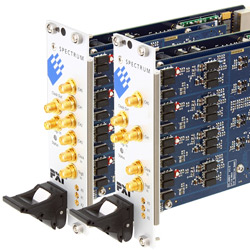Spectrum has released the first high-speed digitizer product line based on the popular PXIe (PXI Express) modular instrument standard. The M4x.44xx series includes six new products, each packaged in a double-width 3U module, and includes a four-lane PCI Express second-generation interface. High-performance interfaces enable data transfer speeds in excess of 1.7GB / s, making these cards ideal for use in today's fastest PXIe mainframe systems.
Digitizers include versions with two and four fully synchronized channels with 14-bit resolution (sampling at up to 500 MS / s) or 16-bit (sampling at up to 130 or 250 MS / s) . This digitizer has an analog bandwidth of up to 250 MHz and is suitable for ATE systems that need to acquire and measure electronic signals in the range of 1 to 200MHz with the best speed and accuracy.
Typical applications include semiconductor and component testing, radar, wireless communications, medicine, automotive, power, physics, surveillance, aerospace and defense systems.
The M4x.44xx series cards are designed to work with the widest range of signals and have an oscilloscope-style front end. Each channel has its own independent monolithic ADC and low noise signal conditioning circuit. These cards are fully programmable and offer six gain input ranges (± 200mV to ± 10V) with selectable input impedances of 50ohm or 10ohm and AC or DC coupling. In addition, the internal bandwidth filter can be activated in cases where it is necessary to suppress high frequency noise that may mask the signal.
The flexible front-end circuit is complemented by a powerful trigger system and a universal clock. The trigger source can be any input channel, two external trigger inputs, eight PXI trigger lines, or any of the PXI star triggers. Trigger modes include rising or falling edges, two edges (windows), software and reset. In addition, you can implement logic triggering based on the status of the channel and external trigger input.
The digitizer's clock system is accurate and advanced. Clocks can be generated internally or externally (including 100 MHz PXIe differential clocks and 10 MHz PXI clocks as sources). It has a built-in 10 MHz reference and can be synchronized with other reference sources if needed. A fine resolution mode is also available, which allows the clock rate to be selected with 1Hz resolution. This feature makes it possible to program the digitizer's sample rate to match the sample rate of other devices, or to set acquisition for special input signal conditions.
All digitizers come with a standard 4 GByte (2 Giga-Samples) onboard acquisition memory. Large-capacity memory makes it easy to acquire long and complex signals. A large number of data acquisition and readout modes further expand this function. These include single capture (transient recording), streaming (FIFO), segmented (multiple recording), gated (gated sampling), or segmented fast signal acquisition in parallel with slow continuous data recording (ABA mode). All triggering events can be time stamped, making it easy to know when they occurred and to determine the time between events.
These PXIe digitizers have low noise front ends, high resolution ADCs, and accurate clocks to provide excellent dynamic performance. For example, the signal-to-noise ratio (SNR) typically exceeds 70dB, the spurious-free dynamic range (SFDR) is better than 90 dB, and the total harmonic distortion (THD) is less than -70dB. This combination can not only detect small signals on large signals, but also provide better measurement repeatability, precision and accuracy.
The new PXIe products are based on Spectrum's reliable M4i family of standard PCIe products, and combine the advanced features and signal quality of the family with the PXIe industry standard. M4x products are two slot wide and can be installed in any PXIe chassis. Compared to the PCIe standard, the PXIe system has an excellent mechanical design, better connectors, and a defined cooling airflow. All these features make it an ideal platform for industrial and mobile applications, including aerospace, defense, and transportation applications. Since Spectrum's M4x platform is based on a modular concept, it also allows for the release of several new PXIe products in a short period of time-all of which are programmed through a common software interface compatible with existing PCIe, PCI and LXI products.
Another advantage of sharing technology between platforms is that the new PXIe module can immediately take advantage of the FPGA-based firmware options already available with PCIe cards. Block averaging and block statistics packets are available for high trigger rate applications that require hardware-based processing capabilities. Block averaging can be used to reduce signal noise and improve measurement resolution, while block statistics perform the peak detection process to produce the maximum, minimum, and average values of the waveform.
To control and operate the digitizer, Spectrum provides a powerful SBench 6 program. SBench 6 supports all key functions of the digitizer and provides data display, storage, analysis and documentation. The program provides oscilloscope and transient recording modes, including data streaming. The basic version of SBench 6 is provided free of charge to enable out-of-the-box operation of the digitizer.
Users who want to develop their own programs can use the proven Spectrum driver (for Windows and Linux) included in the delivery. A set of standard programming examples is provided to illustrate the card's main signal capture functions. The company said that extensive support includes Visual C ++, Borland C ++, Gnu C ++, LabVIEW, MATLAB, Visual Basic, VB.NET, C #, J #, and Delphi code.
